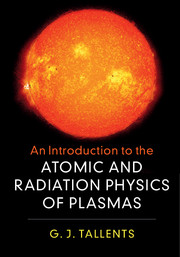Book contents
- Frontmatter
- Contents
- Preface
- 1 Plasma and Atomic Physics
- 2 The Propagation of Light
- 3 Scattering
- 4 Radiation Emission in Plasmas
- 5 Radiation Emission Involving Free Electrons
- 6 Opacity
- 7 Discrete Bound Quantum States: Hydrogen and Hydrogen-Like Ions
- 8 Discrete Bound States: Many-Electron Atoms and Ions
- 9 Discrete Bound States: Molecules
- 10 Radiative Transitions between Discrete Quantum States
- 11 Collisions
- 12 Collisional-Radiative Models
- 13 High-Density Plasmas
- Appendix Vectors, Maxwell's Equations, the Harmonic Oscillator and a Sum Rule
- References
- Index
10 - Radiative Transitions between Discrete Quantum States
Published online by Cambridge University Press: 21 February 2018
- Frontmatter
- Contents
- Preface
- 1 Plasma and Atomic Physics
- 2 The Propagation of Light
- 3 Scattering
- 4 Radiation Emission in Plasmas
- 5 Radiation Emission Involving Free Electrons
- 6 Opacity
- 7 Discrete Bound Quantum States: Hydrogen and Hydrogen-Like Ions
- 8 Discrete Bound States: Many-Electron Atoms and Ions
- 9 Discrete Bound States: Molecules
- 10 Radiative Transitions between Discrete Quantum States
- 11 Collisions
- 12 Collisional-Radiative Models
- 13 High-Density Plasmas
- Appendix Vectors, Maxwell's Equations, the Harmonic Oscillator and a Sum Rule
- References
- Index
Summary
Radiation can change the energy state of matter via three optical processes: spontaneous emission, absorption and stimulated emission. In spontaneous emission, an excited atomic or molecular state decays to a lower energy state with the emission of a photon of energy equal to the difference in the quantum state energies. Photon absorption is the reverse process, with a photon causing excitation from a lower to an excited quantum state. Stimulated emission was first proposed by Einstein in a paper published in 1917. He attempted to balance spontaneous emission and photon absorption, but could not get the correct balance without the postulated process of stimulated emission (see Section 4.2). With stimulated emission, an excited quantum state is stimulated to decay to a lower quantum state by an impinging photon. The existing photon survives with another identical photon being created (so that energy is conserved).
The rates at which radiative transitions occur can be calculated using quantum mechanics. The time-dependent Schrodinger equation is used with the system wavefunction comprising time-varying linear combinations of the two wavefunctions for the lower and upper quantum states. In semi-classical treatments, an atom is treated quantum mechanically with the radiation field treated classically. There is a perturbation in energy associated with, say, the electric field of the radiation interacting with the electric dipole of the atom, though other interactions can be significant if the electric dipole interaction energy is small. In absorption, for example, a differential equation representing the change in ‘weighting’ of the wavefunction from the lower to upper state is obtained. A ‘time constant’ for the speed of change represents the rate of the radiative process. We examine the quantum mechanical nature of radiation absorption in Section 10.1 before discussing (Section 10.3) another important parameter arising with radiative transitions between discrete bound quantum states: the lineshape function.
Quantum Theory of the Atom–Radiation Interaction
An expression for the Einstein B-coefficient for photo-absorption is derived using quantum mechanics in this section. Einstein determined the detailed balance relationship between the rates of spontaneous emission, photo-absorption and stimulated emission when light interacts with an atom by considering an atomic system of two energy levels which are in equilibrium with a black-body radiation field. We use a semi-classical treatment where the atom is treated quantum mechanically and the radiation field is treated as a classical oscillating electric field.
- Type
- Chapter
- Information
- An Introduction to the Atomic and Radiation Physics of Plasmas , pp. 177 - 207Publisher: Cambridge University PressPrint publication year: 2018



